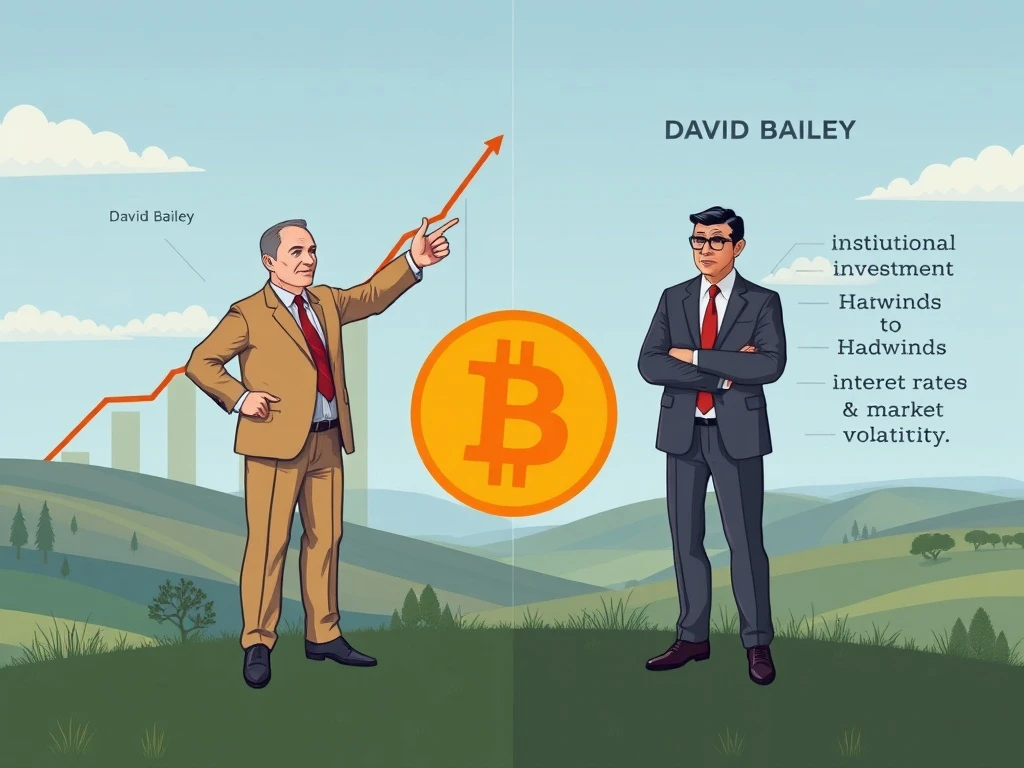Crucial Bitcoin Bear Market Debate: Years Away or Imminent Threat?

The cryptocurrency world constantly grapples with a pivotal question: When will the next Bitcoin bear market arrive? David Bailey, a prominent Bitcoin adviser to US President Donald Trump, offers an optimistic forecast. He suggests a significant downturn is likely years away. However, many crypto analysts present a more cautious perspective. They point to historical patterns and emerging macro-economic factors. This article explores both sides of this crucial debate, offering insights into the future of the crypto market.
Institutional Interest Fuels Bitcoin’s Future
David Bailey, founder of Bitcoin Magazine and BTC Inc., firmly believes the current landscape is unique. He argues that genuine institutional interest now underpins Bitcoin’s ascent. Bailey stated in an X post, “Every Sovereign, Bank, Insurer, Corporate, Pension, and more will own Bitcoin.” He emphasized that this process has only just begun. The total addressable market (TAM) remains largely untapped, with less than 0.01% captured so far. Bailey believes this unprecedented institutional engagement sets the stage for much higher prices. Earlier institutional involvement, he noted, consisted mostly of “outliers with marginal bets.”
Over the past two years, institutions have indeed deepened their exposure. They utilize investment vehicles like exchange-traded funds (ETFs). Many have also established crypto treasuries. Their total holdings now exceed $100 billion, primarily in Bitcoin (BTC). This influx of capital undeniably represents a significant shift. It contrasts sharply with previous market cycles. Therefore, Bailey’s perspective suggests a prolonged bull run, fueled by this continuous institutional adoption.
Historical Market Cycles and Emerging Headwinds
Despite Bailey’s bullish outlook, historical data and expert opinions suggest caution. The cryptocurrency market has historically followed a four-year cycle. This pattern often sees a booming bull market followed by a significant correction. Crypto analysts highlight several potential headwinds. These factors could disrupt the current upward trajectory. For instance, a June report from venture capital firm Breed warned about the long-term viability of some treasury companies. This could potentially trigger the next Bitcoin bear market.
CK Zheng, co-founder and chief investment officer of ZX Squared Capital, notes a strong correlation. He states that crypto remains highly linked to the stock market. If the stock market enters a bear phase, crypto will likely follow. Zheng, however, views a stock market bear market as unlikely for the remainder of the year. This is especially true after recent developments. The Federal Reserve’s pivot towards lower interest rates, for example, offers a positive signal. This suggests a potential shift in broader economic conditions.
The Influence of Fed Interest Rates on the Crypto Market
The Federal Reserve’s monetary policy plays a critical role in market sentiment. Jerome Powell’s recent speech last Friday indicated a willingness to cut interest rates. This is a significant signal for investors. Zheng believes a rate cut is probable in September. This could mark the beginning of a low-interest-rate cycle. Such a cycle would be supported by softening economic data and a loosening labor market. Historically, lower interest rates tend to make riskier assets, like cryptocurrencies, more attractive. This is because they offer higher potential returns compared to traditional fixed-income investments.
Meanwhile, Pav Hundal, lead market analyst at Australian crypto broker Swyftx, observes a “risk-on” market environment. This supports the rotation into high-momentum assets like Bitcoin and Ether (ETH). However, Hundal anticipates a future re-rotation back into fixed-income instruments. He cautions that macro shocks often appear unexpectedly. He also notes that interest rate rises are politically challenging. Yet, the market still expects another rise within the next year. Such a move could serve as a catalyst for a correction, potentially impacting the entire crypto market.
Forecasting Future Market Cycles: Bear or Mild Correction?
Predicting the exact timing and severity of future market cycles remains challenging. Ryan McMillin, co-founder and chief investment officer of Merkle Tree Capital, offers a detailed perspective. He suggests a market top around Q2 2026. A “relatively mild bear market” could then follow by mid-2026. This would likely occur if global liquidity reverses around that time. McMillin identifies two primary triggers for a downturn:
- Leverage unwind: Excessive debt-fueled Bitcoin purchases could lead to rapid liquidations.
- Regulatory shock: Unexpected policy changes could create significant market instability.
Direct access trading (DAT) and institutional markets introduce substantial demand. However, they also carry inherent risks. Some DATs might enter the market late and become overleveraged. They could be unprepared for Bitcoin’s characteristic volatility. This vulnerability could inadvertently trigger the next bear market. Therefore, the expansion of institutional involvement, while bullish, also introduces new layers of complexity and potential fragility.
The Possibility of an Evolving Bitcoin Market
Intriguingly, McMillin also raises a compelling alternative. He suggests the possibility of no traditional bear market at all. He draws a parallel to gold’s trajectory after its early 2000s ETF launch. Gold experienced an “up only” period for eight years as it became financialized. This scenario hinges on the nature of the preceding bull market. A deep, sustained bear market often requires a parabolic bull run beforehand. If the current cycle continues its pattern of steady upward moves with periods of consolidation, the outcome could differ significantly.
These consolidation phases are crucial. They allow leverage to reset. This prevents the build-up of unsustainable market exuberance. If this structure persists, we might see regular corrections instead of a full-blown bear market. Such corrections, McMillin argues, would present excellent buying opportunities. This evolving market structure could fundamentally alter the traditional understanding of market cycles. It would shift the focus from dramatic crashes to more measured adjustments. The debate over the next Bitcoin bear market, therefore, remains vibrant and multifaceted, reflecting the dynamic nature of the crypto space.









